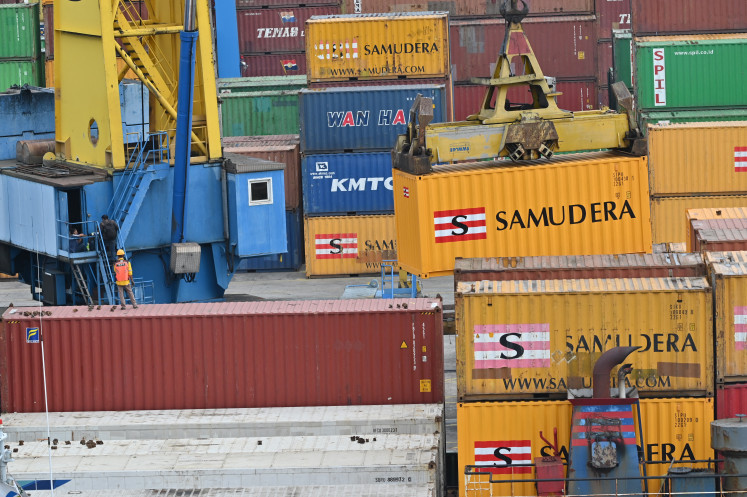Indonesia is home to three of the world's most endangered species
It's easy to become immune to the endless stream of reports about the plight of some of the planet's most endangered species
Change text size
Gift Premium Articles
to Anyone

It's easy to become immune to the endless stream of reports about the plight of some of the planet's most endangered species. But I make no apology for again highlighting how crucial it is for Indonesia to protect its wildlife.
The Worldwide Fund for Nature's (WWF) so-called 9 to Watch in 2009 includes three species that are indigenous to this country. According to the international environmental group, the Javan rhinoceros, the Sumatran tiger and the Borneo pygmy elephant are among the animals closest to extinction.
WWF scientists say these, and many other species, are at greater risk than ever before because of poaching, habitat loss and climate change-related threats.
At the top of the list is the Javan rhinoceros, of which there are apparently less than 60 still surviving in the wild. This is probably the rarest large mammal species in the world and is critically endangered. Poaching and pressure from a growing human population pose the greatest risk to the two protected areas where they live.
The world's smallest and most endangered cetacean, the vaquita, is the second most threatened species. Found in Mexico, this tiny porpoise is often killed in gillnets and could soon be extinct. Environmentalists are working with local fishermen, local and international nonprofit organizations, and private sector and government officials in an unprecedented effort to save the vaquita, of which it is estimated there are only 150 remaining.
It is in Nigeria and Cameroon where the world's fourth most threatened animal, the Cross River gorilla, is hanging onto life by a thread. Sadly there are less than 300 of these animals left in the few remaining forest patches that are their home. Conservation measures are urgently needed for this beleaguered animal, which is probably the world's rarest great ape.
But we return to Indonesia to find the creature that's fourth most likely to disappear forever: The much-reported Sumatran tiger, of which it is estimated that less than 500 are in existence today.
Accelerating deforestation and rampant poaching could push the Sumatran tiger to the same fate as its now-extinct Javan and Balinese relatives in other parts of Indonesia. Tigers are poached for their body parts, which are used in traditional Chinese medicine; skins also are highly prized. Environmentalists are researching the Sumatran tiger population using camera traps, conducting anti-poaching patrols and working to reduce human-tiger conflict as the cat's habitat shrinks. Through the efforts of WWF and its partners, the Indonesian government in 2008 doubled the size of Tesso Nilo National Park, which is a critical tiger habitat.
The North Pacific right whale is ranked fifth in the survival stakes. With a population of less than 500, this magnificent mammal is found in the Northern Pacific of the United States, Russia and Japan.
The North Pacific right whale is one of the world's rarest cetaceans, almost hunted to extinction until the 1960s. It is rarely sighted and has a poor prognosis for survival because of collisions with ships, entanglement in fishing nets and the prospect of offshore oil and gas development in Alaska's Bristol Bay. Work is being undertaken to improve shipping safety to avoid collisions and trying to prevent oil and gas development in Bristol Bay, the whale's primary summer feeding ground.
In sixth place is the black-footed ferret, which is found in the Northern Great Plains of the United States and Canada.
With less than 1,000 still alive, this is one of the most endangered mammals in North America because its primary prey, the prairie dog, has been nearly exterminated by ranchers who consider it a nuisance.
Few species have edged so close to extinction as the black-footed ferret and recovered, but through captive breeding and reintroduction, there are signs the species is slowly recovering. Borneo's pygmy elephant is the seventh most likely to die out with less than 1,000 left.
These smallest of all elephants must compete with logging and agriculture for space in the lowland forests of Borneo. Projects are underway to try to ensure their protection, which includes tracking the elephants through the use of satellite collars to learn more about these little-understood creatures.
With a population of fewer than two thousand, China's giant panda is in eighth place.
Its forest habitat in the mountainous areas of southwest China has become fragmented, creating small and isolated populations. Conservationists have been active in giant panda conservation for nearly three decades, by conducting field studies, working to protect habitats and, most recently, providing assistance to the Chinese government in establishing a program to protect the panda and its habitat through the creation of reserves.
The magnificent polar bear has ninth position with no more than 25,000 remaining in their native Arctic.
The greatest risk to their survival today is climate change. Designated a threatened species by the United States, if warming trends in the Arctic continue at the current pace, polar bears will be vulnerable to extinction within the next century.
Jonathan Wootliff is an independent sustainable development consultant specializing in the building of productive relationships between companies and NGOs. He can be contacted at jonathan@wootliff.com









